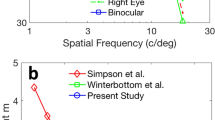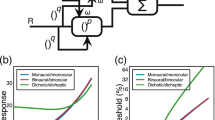Abstract
A single neural model is proposed to account for how responses of the two eyes and two ears combine to form the perception of binocular brightness and binaural loudness respectively. It involves nonlinear reciprocal feedback inhibition between left and right channels, followed by linear summation between the channels. Local circuit synaptic interactions are an important source of nonlinearity. The model combines inputs in a manner that approximates vector magnitude models in general. This suggests that the model can be applied to a variety of circumstances beyond the visual and auditory data discussed here.
Similar content being viewed by others
References
Berglund, B., Berglund, U., Lindvall, T.: Psychological processing of odor mixtures. Psychol. Rev.83, 432–441 (1976)
Blake, R., Fox, R.: The psychophysical inquiry into binocular summation. Percept. Psychophys.14, 161–185 (1973)
Blake, R., Sloane, M., Fox, R.: Further developments in binocular summation. Percept. Psychophys.30, 266–276 (1981)
Buffart, H.J.F.M.: Brightness and contrast. In:Formal theories of visual perception, Leeuwenberg, E.L.J., Buffart, H.J.F.M. (eds.). New York: Wiley 1978, pp. 171–199
Cohn, T.E., Lasley, D.J.: Binocular vision: two possible central interactions between signals from two eyes. Science192, 561–563 (1976)
Curtis, D.W., Rule, S.J.: Binocular processing of brightness information: a vector sum model. J. Exp. Psychol. Hum. Percept. Performance4, 132–143 (1978)
De Silva, H.R., Bartley, S.H.: Summation and subtraction in binocular perception. Br. J. Psychol.20, 241–250 (1930)
de Weert, C.M.M., Levelt, W.J.M.: Binocular brightness combinations: additive and non-additive aspects. Percept. Psychophys.15, 551–562 (1974)
Dierks, K.J., Jefress, L. A.: Interaural phase and the absolute threshold for tone. J. Acoust. Soc. Am.34, 981–984 (1962)
Durlach, N.I., Colburn, H.S.: Binaural phenomena. In:Handbook of perception, Vol. IV, Carterette, E.C., Friedman, M.P. (eds.) New York: Academic Press 1978, pp. 365–466
Engel, G.R.: The autocorrelation function and binocular brightness mixing. Vision Res.9, 1111–1130 (1969)
Fry, G.A., Bartley, S.H.: The brilliance of an object seen binocularly. Am. J. Opthal.16, 687–693 (1933)
Garner, W.R.: On the lambda function, masking, and the loudness of multicomponent tones. J. Acoust. Soc. Am.31, 602–607 (1959)
Goldberg, J.M.: Physiological studies of auditory nuclei of the pons. In:Handbook of sensory physiology, Vol. V/2, Keidel, W.D., Neff, W.D. (eds.). New York: Academic Press 1975, pp. 109–144
Guth, S.L., Massof, R.W., Benzschawel, T.: Vector model for normal and dichromatic color vision. J. Opt. Soc. Am.70, 197–212 (1980)
Helmholtz, H. von:Treatise on physiological optics. Opt. Soc. Am. (1924) (translated from German edition of 1909)
Hirsh, I.J.: Binaural summation — a century of investigation. Psychol. Bull.45, 193–206 (1948)
Hubel, D.H., Wiesel, T.N.: Receptive fields and functional architecture of monkey striate cortex. J. Physiol. London195, 215–243 (1968)
Irwin, R.J.: Binaural summation of thermal noises of equal and unequal power in each ear. Am. J. Psychol.78, 57–65 (1965)
Keen, K.: Preservation of constant loudness with interaural amplitude asymmetry. J. Acoust. Soc. Am.52, 1193–1196 (1972)
Legge, G.E., Rubin, G.S.: Binocular interactions in suprathreshold contrast perception. Percept. Psychophys.30, 49–61 (1981)
Levelt, W.J.M.: Binocular brightness averaging and contour information. Br. J. Psychol.56, 1–13 (1965a)
Levelt, W.J.M.:On binocular rivalry. Soesterberg, The Netherlands: Institute for Perception RVO-TNO 1965b
Levelt, W.J.M., Riemersma, J.B., Bunt, A.A.: Binaural additivity of loudness. Br. J. Math. Stat. Psychol.25, 51–68 (1972)
Macleod, D.I.A.: The Schrödinger equation in binocular brightness combination. Perception1, 321–324 (1972)
Marks, L.E.: Binaural summation of the loudness of pure tones. J. Acoust. Soc. Am.64, 107–113 (1978)
Poggio, T., Torre, V.: A new approach to synaptic interactions. In:Lecture notes in biomathematics, Vol. 21. Theoretical approaches to complex systems, Heim, R., Palm, G. (eds.) Berlin, Heidelberg, New York: Springer 1978, pp. 89–115
Quick, R.F.: A vector magnitude model of contrast detection. Kybernetik16, 65–67 (1974)
Ratliff, F.:Mach bands: quantitative studies of neural networks in the retina. San Fransisco: Holden-Day 1965
Reynolds, G.S., Stevens, S.S.: Binaural summation of loudness. J. Acoust. Soc. Am.32, 1337–1344 (1960)
Rodieck, R.W., Dreher, B.: Visual repression from non-dominant eye in the lateral geniculate nucleus: a comparison of cat and monkey. Exp. Brain Res.35, 465–477 (1979)
Sanderson, K.J., Bishop, P.O., Darian-Smith, I.: The properties of the binocular receptive fields of lateral geniculate neurons. Exp. Brain Res.13, 178–207 (1971)
Schmitt, F.O., Dev, P., Smith, B.H.: Electrotonic processing of information by brain cells. Science193, 114–120 (1976)
Sherrington, C.S.:The integrative action of the nervous system. New Haven: Yale University Press 1906
Singer, W.: Inhibitory binocular interactions in the lateral geniculate body of the cat. Brain Res.18, 165–170 (1970)
Sugie, N.: Neural models of brightness perception and retinal rivalry in binocular vision. Biol. Cybern.43, 13–21 (1982)
Takeuchi, A.: Junctional transmission. I. Postsynaptic mechanisms. In:Handbook of physiology, Sect. 1, Vol. 1, Kandel, E.R. (ed.), Bethesda, MD: Am. Physiol. Soc. 1977, pp. 295–327
Thorn, R., Boynton, R.M.: Human binocular summation at absolute threshold. Vision Res.14, 445–458 (1974)
Torre, V., Poggio, T.: A synaptic mechanism possibly underlying directional selectivity to motion. Proc. R. Soc. London B202, 409–416 (1978)
Treisman, M., Irwin, R.J.: Auditory intensity discriminal scale. I. Evidence derived from binaural intensity summation. J. Acoust. Soc. Am.42, 586–592 (1967)
Author information
Authors and Affiliations
Rights and permissions
About this article
Cite this article
Lehky, S.R. A model of binocular brightness and binaural loudness perception in humans with general applications to nonlinear summation of sensory inputs. Biol. Cybernetics 49, 89–97 (1983). https://doi.org/10.1007/BF00320389
Received:
Issue Date:
DOI: https://doi.org/10.1007/BF00320389




